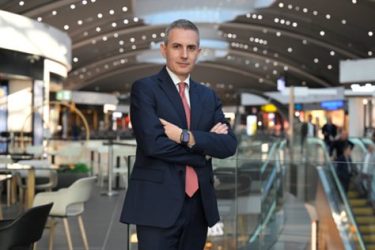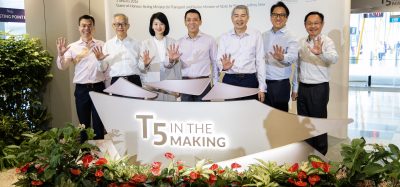Positive business outlook for Aeroporti di Roma: A five star airport
Posted: 13 August 2024 | Federico Scriboni | No comments yet
International Airport Review’s Editorial Assistant, Chunekshi Wimalasuriya, caught up with Federico Scriboni, Aeroporti di Roma SpA’s Director of Aviation Business Development at Routes Europe 2024. In this exclusive Q&A, Federico details business plans for Aeroporti di Roma that is set to appeal to airlines and ensure the financial existence of the company.


Credit: Fiumicino Airport
Could you introduce yourself and your role at Aeroporti di Roma, and give a sense of your background and aviation history?
I’m in charge of Aeroporti di Roma’s aviation business development as a Director. I take care of all the development of the airlines’ activity in our airports. In Rome, we manage both airports, Leonardo da Vinci–Rome Fiumicino Airport (FCO), which is our intercontinental hub and Rome Ciampino International Airport “G. B. Pastine” (CIA). That is our secondary airport in the city.
How is business going for the two airports and how was it last year?
DON’T MISS OUR EXPERT REPORTS FROM 2025
♦ Rethinking security for smart airports
Access your free eReport and discover how leading airports are transforming security from a bottleneck into a strategic advantage.
♦ Securing airports in an evolving threat landscape
Take a strategic look at airport vulnerabilities, giving practical advice on how to stay ahead of the next threat and keep your airport away from the news headlines.
♦ Smart Airports: From Curb to Runway
This report addresses your key pain points: data silos, operational inefficiencies, passenger friction, and staff shortages.
We closed 2023 with 44.4 million passengers. This was split across FCO and CIA, where we got 40.5 million passengers at FCO, while CIA received 3.9 million passengers.
Speaking of Fiumicino Airport, the airport closed the year with an overall traffic recovery of 93% and this result is due to a combination of elements. We started the year with low recovery, due to some ongoing limitations. But from October 2023, we overtook 2019 levels, so that, by October, we saw a rise of 1% traffic as compared to October 2019. This continued in November with an increase of 4% traffic and in December, plus 6%.
Now, at the beginning of 2024, it is getting better. We received an increase traffic rate of 8% in the first three months of 2024. April achieved well, having attracted an increased traffic rate of 10% as compared to April 2019.
This is important to say because we are looking at 2024’s summer programme and are aware that, among the top 10 European airports by passenger traffic, Rome Fiumicino will have the highest growth in terms of capacity.
What would you say is your business model to help grow these two airports in 2024? And how do you work with airlines to create a business model that helps supports the growth of all stakeholders involved?
We have a dedicated team of people specifically working to develop the airline traffic and the network of routes that directly serve the airport. More generally, our proposition is made of a combination of winning elements.
First of all, we offer airlines access to one of the biggest and most attractive markets all around the world: Rome. At the same time, we offer probably the highest possible level of quality that an airport can in Europe. We were rated five stars by Skytrax at the beginning of 2023. We have been the second airport in Europe, after Munich, to receive this rating. I’ll mention another award, delivered by Airport Council International (ACI World), who credited Fiumicino as the best airport in Europe for the seventh year in a row. This is a demonstration that we are very consistent in our quality strategy.
Last but not the least, just recently we got a new award by Skytrax; we have been awarded the best airport into the world for the security process.
Traffic demand, quality, but also commercial policy is essential to attract and develop carriers. We can count on the complete and competitive commercial policies, made up of incentives, to stimulate the enlargement of our route network.
It helps in launching new destinations and the launching of new routes. We can also count on airline marketing and operational support to have joint promotions when a new route is coming.
What would you say are the difficulties and challenges you’re facing at the moment?
If we look at the airline industry, and the aviation industry more globally, I think the biggest challenge is related to the industry capacity and that the industry is not able to cope with such a high level of demand.
the biggest challenge is related to the industry capacity and that the industry is not able to cope with such a high level of demand”
There are several examples of this, starting from the problems that the Pratt & Whitney (engines that are actually reducing the number of aircraft 320 families available on the market. Also, I should mention the Boeing 737 max issues.
The weakness of the whole industrial chain is that it is reducing the industrial capability of airlines’ manufacturer companies to deliver the additional capacity that the market is asking for.


In terms of passenger volumes, we are forecasting traffic to easily overtake 2019 levels (which was a record year for us). As for cargo, it’s the same, even better I would say, because cargo is strongly growing.
In the first three months of 2024, we are growing at a rate of plus 40%, versus the cargo rate we managed in 2019, and this is growing at a rate of plus 70% year-over-year. This is due mainly to a very wide offer of long-haul destinations that we are putting on the market.
To give you an example, North America is already booming. For the summer of 2024, we are going to have a peak time of up to 39 daily departures and daily arrivals – 12 from North America, including the U.S., Canada, and Mexico. All these big mass of flights will be delivering cargo.
For the first time in continental Europe, flights have been launched from New York to Rome via Fiumicino Airport. What does this route reflect on the route development strategy and how did this particular story become a success?
Actually, we got this record last summer in 2023. We had, at that time, up to 11 daily departures and 11 arrivals to New York including both John F. Kennedy International Airport (JFK) and Newark Liberty International Airport (EWR). For this summer, we are confirming the overall programme and we are adding flights on a Saturday. All-in-all, including Saturday, we will have up to 12 arrivals and 12 departures per day from Rome to New York.
This positions Rome to be the second airport in Europe, continental Europe after Paris, Charles de Gaulle, to have this rate of daily flights to New York.
When launching new routes, where do you look to generate the revenue? What sort of revenue streams help with that?
Every time we launch a new route, we generate additional revenues for the airport. The fourth driver in heading a new revenue is from aviation revenues.
Revenues come from the airport charges. This includes both landing and take-off charges, plus passenger charges. That’s why it’s very important not only to get additional flights, and get landing and take-off charges, but also to help airlines increase the number of passengers on-board.
In this case, we will receive additional revenues on the passenger’s part. On top of that, when a new route is launched, more passengers are passing by the airport, eating, buying, and this is the additional line of revenue that we take. The commercial revenues.
The airport is part of a bigger system. When we launch a new route, this new route brings new passengers which create added value for the city; it adds value to the municipality in terms of tourist arrivals and for business developments. This is a full benefit for our local economy and our territory.
How does your airport provide passengers a sense of place?
We are trying to capture the feeling at our airports of being in Italy, and being in Rome. Airports can sometimes be referred to as no more and no place. This is not our case. Rome Fiumicino is a place, a very specific place is Rome, is Italy. And when you are experiencing our airport, you can feel it from all possible angles.
About the author


Credit: ADR
Federico Scriboni is a Senior Executive with almost 20 years’ experience in the aviation industry. Federico graduated in Economics and got a Master’s Degree in Marketing Management at La Sapienza University in Rome. He started his career working in the consumer goods sector as Junior Brand Manager in SAB Miller plc Group and moved in 2006 to the aviation industry having growing responsibilities in the commercial and marketing development. After starting as Revenue Manager, he moved to the Strategic Marketing and Planning in Alitalia with co-ordinating tasks across marketing, sales and network. Following his professional interest for the international aviation business he moved in 2010 to Aeroporti di Roma (ADR – Rome Airports Company) as Route Development Manager Europe for Rome FCO airport. Over the last years Federico has covered growing responsibilities taking in 2016 the lead in managing the whole Airline Traffic Development team for both airports managed by ADR (Rome FCO and Rome CIA). He is now the Aviation Business Development Director, having the main responsibility to expand the aviation business opportunities for Aeroporti di Roma Spa. In the period April 2021-April 2024 Federico has been part of the Board of Directors at Assoclearance (the Italian slots co-ordinator association) as Vice President.
More Like This
Increasing air routes to downtown San Francisco
Heathrow Airport on empowering the next generation’s careers in aviation
Accelerating advanced air mobility (AAM) in Italy
18.9 billion passengers are coming. Is your airport ready for 2026? ✈️
Access the FREE Airport Industry Intelligence Handbook for expert strategies on scaling sustainably, modernising ATM, and securing cargo logistics.
Featuring insights from ACI World, TIACA, CANSO, and ACI EUROPE.
Related topics
Airlines, Passenger experience and seamless travel, Route development
Related airports
Leonardo da Vinci–Rome Fiumicino Airport (FCO), Rome Ciampino International Airport "G. B. Pastine" (CIA)


















